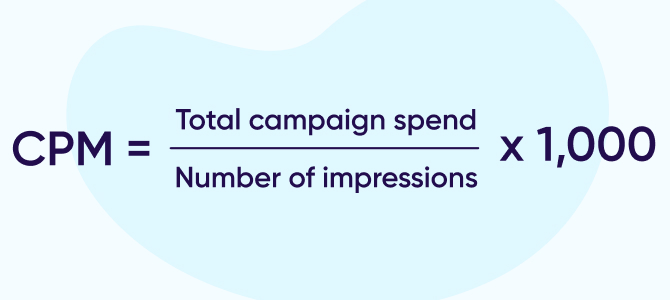
Cost per mille (CPM)
CPM / cost per thousand is a marketing phrase used to indicate the cost of one thousand ad impressions on a web page. The “M” in CPM stands for “mille,” which is Latin for a thousand.
What is Cost Per Mille?
In the programmatic advertising ecosystem, you can automatically buy and sell digital ad inventory. Cost per thousand is the pricing model used for certain programmatic ads in the programmatic ecosystem.
In the real world, this works best for larger publishers because advertisers pay a set price based on the number of impressions an ad placement receives — either monthly or quarterly.
Why is CPM important?
CPM is only one of numerous digital advertising pricing models, which are appropriate for different types of ad campaigns. Advertisers working on brand awareness or focused messaging use a cost per mille model because it captures exposures over “clicks.”
Let’s say you have just perfected the ideal vegan, gluten-free granola, and are ready to get your name out there. Serving your ads on the Whole Foods site or other local organic market sites gets eyeballs on your brand and a “coolness by association” factor, which can help you build your brand recognition.
In this scenario, where you are in a niche market with a niche product, CPM is the way to go in order to start building recognition of your name and brand.
How do you calculate CPM?
Calculating cost per thousand is an important metric and is represented formulaically as:

So, if you paid a publisher $1,500 to serve your ad and that ad received 750,000 impressions, you paid $2 for every 1,000 impressions.

Conversely, publishers can use a CPM calculator to offer their inventory based on the number of potential impressions an ad receives. Let’s say you offer 250,000 impressions — divide that by 1,000 (250), and then multiply it by the CPM. For this scenario, we will call it $5.00.
This lets you know potentially how much an ad can earn for you. In this example, as the publisher, you’d earn $1,250 for 250,000 impressions.

What is an average CPM rate?
To make better ad spend decisions, it’s important to understand the value of where your impressions are served. Therefore, depending on platforms and locations, CPM rates tend to vary greatly.

However, if we isolated that down to a specific platform and location, you would notice discrepancies.
For example, as of September 2021, Facebook’s “highest advertising cost-per-mille (CPM) was in the United States, valued at 35 U.S. dollars in the third quarter … [and] the lowest CPM, one U.S. dollar, was recorded in Pakistan.”

It’s not just geography, though. Even Covid-19 impacted CPM rates. By the middle of March 2020, brands were paying on average 81 cents for a thousand impressions on Facebook ads.
Yet, in November 2019, the cost was $1.88. This indicates that advertising on Facebook had become cheaper because of Covid’s impact on social media usage.
So, there’s no specific average rate per CPM; there are trends to notice at various times and on various platforms and locations, and that will help you determine how valuable impressions are — when and where they’re being served.
How does CPM compare to other advertising metrics?
Now that we know the what, how, and when to use the CPM pricing model for digital marketing, let’s see how it compares to other pricing models in the programmatic ecosystem.
CPM vs. eCPM
First and foremost, eCPM is a metric used by publishers.
Let’s say a mobile app’s ad earned $175/day and served 100,000 ad impressions. Therefore, the publisher or app developer’s eCPM is calculated in the following way:
$175 ÷ 100,000 × 1,000 = $1.75 eCPM
In other words, for every 1,000 impressions, the publisher or app developer will generate $1.75 in revenue.
On the other hand, CPM is a price and reach metric employed to estimate the cost of a campaign and its reach within an advertiser’s budget.
CPM vs. CPC
Rather than paying per 1,000 impressions, the cost-per-click (CPC) model has advertisers doing just that — paying per click, so if the ad results in no clicks, the advertiser isn’t charged.
For advertisers whose ads aren’t getting much love via those clicks, they are still possibly getting thousands of impressions for free because people are seeing the ad even if they are choosing not to “click.” Obviously, for publishers, this means you won’t be paid.
This method can be very costly for advertisers — imagine the click-through rate (CTR) of an ad well received, but very lucrative for publishers.
This is why the CPC method is perfect for driving conversions — be it site traffic or sales), and the CPM model is valuable for advertisers that want to create brand awareness.
CPM vs. CPA
CPA, or cost per action, “refers to a type of pricing model where marketers pay ad networks or media sources for certain conversions (such as a purchase or registration) that happen inside of an app after engagement with an ad.”
Basically, CPM is all about the impressions and impressions only, whereas CPA is all about quantifying the number of people who took specific action in benefit to your ad campaign — after engaging with your ad.
Key takeaways
Along with remembering that the M in CPM stands for ‘thousand,’ here is what else you need to remember about CPM:
- CPM indicates the cost of one thousand ad impressions on a page or site.
- It’s the best pricing model for larger publishers because advertisers pay a set price based on the number of impressions an ad placement receives.
- It’s represented formulaically as: Total Campaign Spend ÷ Number of Impressions × 1,000.
- There is no way to average a specific rate per CPM — rather, rates are calculated and determined based on time, platforms, and location.
- CPM is used by advertisers and publishers to estimate ad spend within a budget, whereas eCPM is used by publishers. CPC pricing models are better to drive conversions, and CPA models are used post-engagement with an ad.




